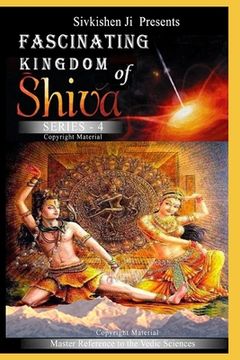Reseña del libro "Fascinating: Kingdom of Shiva Series-4 (en Inglés)"
Sivkishen Ji ensured that the Fascinating Kingdom of Shiva Series-4 come to life with the main character Syamala, became Sthapati Sivani, the chief Sevita of Kanakachala Temple. She became an authority on Vedas, and Agamas, since learned all sciences from Yoginis, Yakshini, Matrikas and the guardians of Sri Chakra. She was training 1404 Kanya Sevita to ensure their devotion to the service of Kanakachala Temple.The story of goddess Bhagavathy changed the mindset of Asura Bana and turned him as her one of the best devotees. Asura Bana was responsible starting the development of temples of Kanya Kumari in all the lower worlds. These temples built the Vedic way, in different size, shape, and locations.The author detailed fascinatingly on performing rituals in worship of mother goddess with wonderful devotion. He gave the Vedic Scientific facts on the worship, connected temple services of Puja rituals and items and panchagavya, mixture of five cow products. When used in Ayurvedic medicine, it is cowpathy. The three direct constituents are cow dung, urine, and milk; the two derived products are curd and ghee. He dealt on the science of ornaments corresponding to different 'pressure points' on the body. Each part of the human body is divided into two parts - the Upper and Lower level. In the lower part, below naval, they used all silver made items, wherein in the upper portion they used Gold made ornaments. By adoring, the ornaments made by good metals one is protected from the negative energies. Silver ornaments, when decked below the naval, will protect the harmful germs. This is an essential knowledge that gets unfold the divine sciences of Metals, Gems, Acupressure, Human Anatomy (structure) and physiology (function). The author detailed on the necessity of virgin worship or Kanya Puja. This is to recognize the feminine power vested in the girl child and to give them as much importance in the social fabric. This based on the Taittiriya Samhita of Krishna Yajur Veda. This also explains on worshipping married women as detailed in the Lalitha Sahasranama Verses 177 and 178 He detailed how the numerous pillars, each of which includes separate columns that sound musical notes when struck with a finger. Different columns in a pillar produce sounds of different frequencies. Moreover, several multi-columned pillars make sounds similar to specific Indian musical instruments such as the ghanta (bell), mridanga (percussion), or veena (strings). The physicists applied three techniques to learn about the structure of the columns and analyzed recordings of generated sound. The metallography with the typical microstructures has both low-frequency ultrasound and impact-echo testing revealed all the columns to be solid shafts. From those studies and spectral analyses, the researchers conclude that the pillars' sounds arise from the flexural mode of vibrations. He also dealt with the process of performing Agnihotra regarded as a process of purification of the atmosphere. The pure atmosphere helps to maintain the purity of character. This explains the significance of the fragrant flowers, herbs, and dried roots of medicinal plants. He detailed on the 'Divine Dance' on three elements of Nritta, Nirtya, and Natya as dealt in the Lalitha Sahasranama, Devi Bhagavat Purana, and Devi Gita. This demonstrates performing Mahisasuramardini in the prominent dance styles of Bharatanatyam, Kathak, Kathakali, and Kuchipudi to give a glimpse of Natya Sastra performance. The reader will enjoy reading this descriptive chapter on the performers' movements of the face, the eyebrows, the eyeballs, the cheeks, the nose, and the chin minutely worked out and various emotions registered in a flash. It predominantly includes the leg, hip, body and arm movements complemented by Hasta Mudra for expressions. The gestural language is a grammatically complete language of hand symbols equivalent to speech especially eyes and mouth, body expression...

